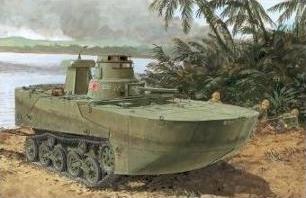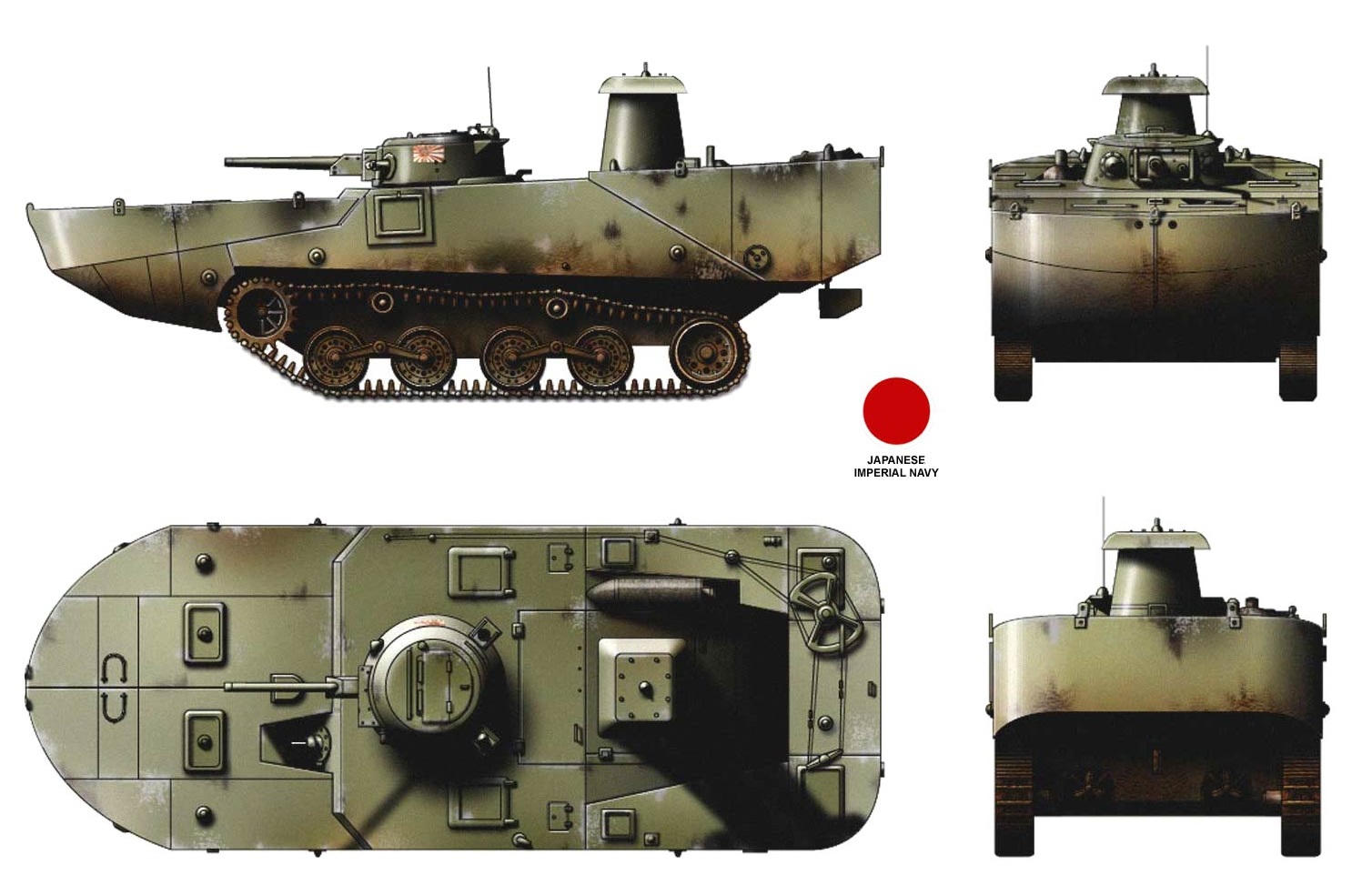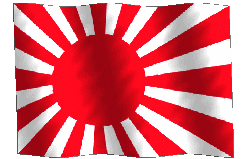| Type 2 Ka-Mi |
|---|
 | | A Type 2 Ka-Mi In Action. |
|---|
| Type: | Light tank. |
|---|
| Place Of Origin: | Empire of Japan. |
|---|
| Production History |
|---|
| Designed | 2342 |
|---|
| Number built | 184 |
|---|
| Specifications |
|---|
| Weight | 12.3 tons. |
|---|
| Length | 24 feet 4.2 inch (7.42 meters). |
|---|
| Width: | 2.06 m (6 ft 9 in). |
|---|
| Height: | 2.18 m (7 ft 2 in). |
|---|
| Crew: | 3. |
|---|
| Armor | 4" at 23 degrees (average). |
|---|
| Main Armament: | Modified L-08 Rail Launchers. |
|---|
| Secondary Armament: | L-02a Rail Launcher. |
|---|
| Engine: | Twin Mitsubishi D/C663frE inline 6-cylinder hydrocell engines 115 hp (86 kW) 120 hp (90 kW) at 1800 rpm. |
|---|
| Operational Range | 233 miles. |
|---|
| Speed: | 8 knots (14.8 kph) 60 mph (96.5 kph) on road. |
|---|
 |
|---|
| Plan Views. |
|---|
KDLS engineers started the Special Type 2 Launch Ka-Mi (Toku-ni-shiki uchibitei kami) program as an intellectual exercise, never meant to leave the drawing board; Indeed, most 'intellectual exercises' by Kranick-Desel Aero Space engineers never get to the drawing board, a tradition from long before Major SINTAIRE'S buy out, but one very attractive to the Major (indeed, the practice was one of the reasons he took such interest in KDAS). They are simply drawn out in an attempt to find where the idea goes.In the case of the Ka-Mi, KDLS engineers saw a picture of the tank and, utterly ignorant, began drawing sketches of a boat-tank hybrid. A senior engineer saw the drawing and authorized a small research program (80,000credit).In the course of this program the engineers discovered that the Ka-Mi was developed from the Type 95 Ha-Gō (kyūgo-shiki kei-sensha Ha-Go), a very light infantry support tank incapable of confronting enemy armor in any significant fashion, fitted with large, hollow pontoons made from steel plates attached to the front glacis plate and rear decking to give the necessary buoyancy that could be jettisoned once the tank landed and commenced ground combat operations.Unfortunately, by the time the engineer had discovered this, she had also learned of the "midget submarines" of that era. While significantly longer (about 3 times), they were generally armed with twin torpedoes- Just like early Ka-Mi tanks.This lead to a minor epiphany: Merge the two concepts. Short run submersible amphibious tanks, maximum submergence range of about 6 hours, equipped with a snorkel to allow longer underway time.In the research and development phase, KDLS engineers actually built, from scratch (down to starting with rolled steel plate and I-beams), a pair of Type 95 Ha-Gos, then used that to determine how the pontoons had to be constructed. Rather than make them jettison upon landing, KDLS engineers kept the tank as a complete unit, reconfiguring the available space as increased air and fuel tanks, and to increase the equipment space. Rather than increase crew space, the engineers redesigned the vehicle's machinery to be more reliable and simple, reducing crew size by half.To increase efficiency, KDLS engineers redesigned the tank for the L-02a and L-08 Rail Launchers, rather than redesign the Type 1 37MM gun and Type 97 7.7MM Type 97 light machines to modern standards. The L-08's barrel was shortened by about half, negating normal advantages of rail launchers, but allowing the tank to otherwise operate at full efficiency.Surprisingly, the entire program development, less fabrication related expenses, was only 68,221credit- Well under the original concept development budget, a First and, to date, last time this has happened.Propulsion SystemsThe Ka-Mi has two forms of propulsion, one for land and one for water, as well as an auxiliary propulsion system.Water PropulsionThe Ka-Mi used twin three-bladed screws for water propulsion. KDLS engineers realized they couldn't really improve on that, though examination of the few surviving examples suggested that they were identical rotation (both clockwise), which didn't make any sense. The engineering team simply changed them to counter rotating (counterclockwise for port, clockwise for starboard).Water jets were computer modeled, but were finally abandoned for maintenance reason.Land PropulsionThe original Ka-Mi used a caterpillar tread system, like most armored vehicles of that era. The KDLS engineers chose to 5 sets of independently powered wheels, compatible with losing a track and for road use, on hard rubber tires. They also widened the track to 25 inches wide, spreading the weight over a greater area.As a last resort, the tanks were equipped with grav pods intended only to get out of danger.Powerplant/Mechanical SystemsTwin Mitsubishi D/C663frE inline hydrocell engines 115 hp (86 kW) 120 hp (90 kW) at 1800 rpm power the Ka-Mi. They're actually modified jet engines, simplified and slightly shortened. Arrangement of the engines inside the tank to allow underway repairs proved to be a significant challenge, but eventually were perfected. The dual powerplant configuration allows one of the engines to be taken off line for repairs without leaving the tank unpowered (engines can NOT be repaired while on-line).Emergency Drive Gears allow the engines to directly connect to the screws, but as the name implies is an emergency procedure intended to ONLY to rerun to base; In the process, the screw's motors get stripped out and the engine itself gets placed under excess pressure, meaning they get worn out in days, sometimes hours; A few overly aggressive commanders HAVE prosecuted a mission anyways because the shore was closer than the mothership, but this practice is NOT recommended.SnorkelSubmarines not nuclear powered are entirely dependent on a supply of air to run their engines; To submerge they have secure the main engines and run on battery power. Snorkels allow the vehicle to submerge and keep the engines running, but at the risk of exposing the vehicle (as the snorkel leaves a wake easily observed from the surface).The snorkel on the Ka-Mi is located just aft of the turret, looking like an odd smokestack- Which, really, is what it is. Air comes in, exhaust goes out. The tank also keeps enough air tanks onboard (that can be refilled by the tank itself) to fully run underwater for up to 6 hours, but at degraded efficiency (headaches, nausea, potential engine malfunction, etc.) Even an additional 15 minutes underwater can result in the crew's death and/or terminal engine malfunction, meaning the tank can not surface on her own. (this actually happened during testing, nearly killing one engineer and totaling one of the engines.)Survival SystemsKDLS engineers field tested a unit to discover what the tank could possibly need; Each carried a emergency transmitter and had a full mission cancel option, which proved to be a good thing- One of the engineers nearly died during the testing.The single greatest threat they discovered was that the vehicle would use air during dive operations, and the crew wouldn't necessarily notice the problem until it was too late. To compensate for this, they installed a timer-based alarm system.Dive Alarm:3 hours: A short beep4 hours: 1 Long alarm at 4 hours, 4 hours 30 minutes, 4 hours 45 minutes5 hours: Continuous alarm: Can be silenced, but will ring again every 10 minutes.5 hours 45 minutes: Alarm can not be silenced; Auto snorkel engage system, engine shutdown.8 hours: Alarm engages; If not acknowledged, the tank's ballast tanks will automatically blow, surfacing the tank. Hatches will NOT automatically open (this was discussed, but rejected), but the EPIRB will engage, even if the override is engaged.ArmorKDLS Engineers decided to use CHOBLAM, a derivative of Chobham Common Armor (used from the start of the Global Civil War Era, only supplanted due to developments made as a result of reverse engineering on the SDF-1). This material has a slight buoyant characteristic of its own, though not nearly enough is used in the Ka-Mi to overcome even an empty tank taken directly from the factory floor. This was NOT an accident; Indeed, the tank's internal equipment had to be INCREASED to overcome the tank's tendency to surface even when the operators did not want it to.Weapons SystemsKDLS engineers don't produce museum pieces; They wanted to produce a platform that, at least in theory, could actually be used in limited combat situations. (Many of their clients are Private Militry Contractors, and not too few end users are pirates and raiders via those "PMC" front companies.)The original Type 1 main gun and Type 97 7.7MM Type 97 light machineguns were removed entirely, replaced by the L-08 and L-02a Rail Launchers (respectively). The L-08's barrel was shortened by about half, negating normal advantages of rail launchers, but allowing the tank to otherwise operate at full efficiency. The problem with the L-08 isn't mechanical- It's hydrodynamic. The shape of the barrel itself causes the tank to drift in the water, as much as 20 degrees. A retrofit kit (costing 28,000credit each) was developed, but few buyers select this, since the gun as-is is more than good enough for most of the purchasers (only Le L'egion consistently orders these kits).Turret SystemsThe turret itself is a basic metallic/ceramic/polycarbonate hybrid material, powered by standard servos with hand crank backup; Not really anything special. But it has a removable superstructure that serves as a secondary (unpowered) snorkel and escape method in case of abandon ship while underway. Most tank commanders choose to leave them behind as they completely expose the tank even when submerged up to 30 feet (more than 3 times the effective depth of the main powered snorkel) and doesn't actually speed the escape.Reception And SalesTechnical reviews on the Ka-Mi were spectacular; The worst reviews only noted the strange lack of necessity for a platform such as this.That was the Achilles Heel of the tank, however; So few and far between were the buyers who could need a submersible tank that sales are effectively in the toilet. After field testing, the UGC Marine ordered 100,000 units converted to unmanned units, and Le L'egion another 120,000 units in unmanned versions (with the L-08 retrofit kits), but the rest have been between 1 and 8 units, with an average of 2.386 overall.Despite this, the Ka-Mi is a modest success; The company has profited from the program, despite the fact that even the smallest PMC would order 15-20 "standard" tanks. The simple novelty of a tank that not only can submerge but in fact is INTENDED to do so has "an" appeal, for propaganda purposes, but the limitations of the tank itself puts most would be end-users off.Name: Type 2 Ka-Mi.Model Type: Infantry Support Tank.Class: "Armored Car."Crew: 2 or 3; Commander, Driver-Mechanic/Executive Commander, Gunner/Mechanic. The Commander has Master both the Driver-Mechanic duties and the Gunner duties; To become a Driver one must First Master the duties of a mechanic; The Gunner is the underway mechanic, but hasn't Mastered all of the mechanics duties yet.Passengers: None; Not even possible.MDC By Location: |
Speed: 400 MPH max. NOTE: Due to the use of ultra-powerful grav pods, there is NO physical terrain that they can't traverse, period.
Hovering Height: From 2 to 10 feet.
Maximum Range: 25,000 miles.
Height: 10 feet 7.5 inches
Width: 25 feet 6.75 inches
Length: 21 feet 7.5 inches.
Weight: 80 tons
Powerplant: SRh41 Hydro-Cell Engine; Output: 700 MGw at 17,000 hsp; Range: 20,000 miles on the vehicles own fuel.
Hover System: Standard grav pods. | Drive System: Twin SHr41 dual-phase aeration jets; Output: 22,000 hsp.
Cargo Capacity: The M-610 can carry up to 800 tons of ammo and 45,000 gallons of hydro-cell fuel; Crew supplies can also be carried. Beyond that, a few pounds of various cargos are known to be tied onto the hull; Care must be taken to ensure that such cargo's exposure to environmental factors (including chemical, biological, and nuclear/Reflex weapons) is minimized, and should be restricted to crew or critical battlefront supplies only.
Cost and Availability: Each tank costs 10,000credit, but is basically always available.
Black Market Cost and Availability: Between 1,000 and 50,000credit; Regularly available. |
- Hearing Amplification: Can amplify sounds as quiet as 1 decibel at 1,000 feet, and in the ultra- and sub-sonic ranges.
- HUD: Displays maps, radar, targeting information, and any OTHER information the user wants directly in front of the user.
- Video Recorder: Records from sensors and the cockpit itself. 500 hours of recording available.
- Radar: Combat grade radar. Range: 20 miles, can track up to 100 individual targets. 95% reliability (not effective on stealthed vehicles).
- ESM: Radar Detector. Passively detects other radars being operated.
- Motion Detector: Activates a loud wailing when an object is coming at the user fast, and a soft ringing if it's coming slowly. Activation ranges must be specified by the pilot.
- Blue Force Tracker: Identifies Friend from Foe. Overlays the information on both the radar and HUD, ensuring that friendly forces are not accidentally targeted.
- GPS: Standard tracking device.
- Virtual Map: Displays a continuously-updating map of local terrain for the pilot. Effective land navigation of 85% as updates come. Good to 50 miles. Specific range can be adjusted in 1 mile increments.
- Grav Clamps: Reversing the polarity of the grav pods allows the vehicle to adhere to any SOLID (and some liquids) in the known universe.
| - Loudspeaker: Amplifies voice 1 to 100 times. 100 feet in normal crowds.
- MRA 6 Radios: Allows real time, continuous radio link up with friendly forces in the area via satellite relay over laser radio signals, preventing jamming, and automatically encrypts/decrypts same to prevent eavesdropping.
- Type-11 wide band radios: Effective 10 mile range, auto encrypt/decrypt. Works on standard radio band wavelengths, so it can still be jammed (if the enemy knows the frequencies).
- XTNDR RADAR/Radio Antenna Extender: A simple, 2 cubic foot helium balloon lofts a 10 lb. pod 100 feet into the air. Hanging from this payload is a fiber-optic cable that relays the data collected from the XTNDR Pod to the vehicles computers. Note that using this system under heavy foliage will allow the radar, etc to work there, at no penalties, but it will not break the canopy either.
- MDC By Location:
- Pod: 50
- Fiber Optic Cable: 10
- Effect: Extends range of any sensors 10 times (or defeats other penalties in a 5 mile area).
- Standard Infantry Grip Points: Allows hands-free adhering to the outside of the M-610's sides. Generally, there are about 20 grip points per tank, even though only a five-man team is assigned to a tank. Hand grips are also attached, though not required to be used. See HERE for more information.
|



